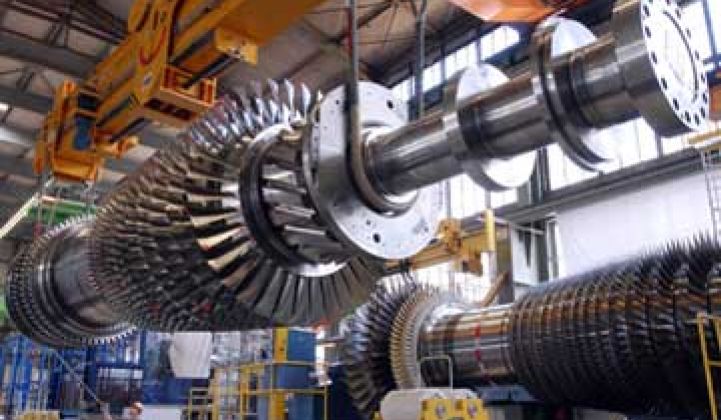Although Siemens is global, it is trying to think local.
The company's most efficient gas turbine, the H Class, is already being produced in Germany, which boasts a high level of renewable energy penetration. On Wednesday, Siemens opened a new 450,000-unit gas turbine production facility in Charlotte, N.C., next to its existing steam turbine generator plant.
The formal opening of the plant comes as international players jockey to produce the most efficient gas turbines and combined-cycle natural gas power plants possible. Earlier this year, General Electric announced a new 510-megawatt combined-cycle power plant that claims fuel efficiency of up to 61 percent. North Carolina, home to the high-tech cluster known as the Research Triangle, is also steadily wooing large corporations to set up their energy research and production facilities in state, including ABB and Siemens.
When Siemens' new facility is fully operational in 2012, it will employ 1,800 people and produce all the components of the combined-cycle power plant in one location. Although these power plants play well with intermittent renewables, Siemens says that is not the driver to ramp up production in the U.S. “We think the combined-cycle power plant will play the major role in repowering the U.S. and the world,” said Mark Pringle, director of operations for Siemens Energy in Charlotte. “It will have the biggest impact, bigger than renewables.”
Renewables, including wind and solar, are small but growing sources of energy in the U.S. Hydropower continues to be the leading renewable energy source. But many states are mandating 30 percent (or even 33 percent, in California's case) renewable portfolio standards, and many existing power systems are just not equipped to handle that level of variability.
Enter combined-cycle gas turbines, which can ramp up or down much more quickly than can coal-fired power plants. But replacing coal with state-of-the-art, gas-fired combined-cycle plants is where the real benefit is, said Pringle. He noted that a Siemens plant can reduce CO2 output by about 30 percent compared to new coal plants. The company's latest turbine is 50 percent cleaner than any previous turbine.
The Charlotte facility will focus on 60 Hz turbines, which is the power frequency used in the U.S. The German facility will continue to make 50 Hz turbines for the European market.
The first turbine to roll off the production line in Charlotte was not the H Class, but rather an F Class turbine headed to Mexico. Production of the H Class turbine, which Pringle said is nearly 61 percent fuel efficient in combined-cycle mode, is expected to begin in 2012. It will likely be a photo finish in a head-to-head race between GE and Siemens turbines.
Efficiency was not just a priority for the products coming off the line, but also for the manufacturing plant. “We designed it to reduce waste anywhere we could,” said Pringle. The company expects to sell at least 10 turbines annually, at a cost of $2 million to $3 million each.
Siemens' first complete 400-megawatt combined-cycle power plant, equipped with its H class turbine, is headed to Seoul-based GS Electric Power. It is expected to come online in the summer of 2013.



